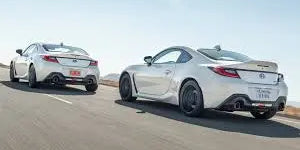You’d never guess it from their worldwide dominance today, but Toyota started from the humblest of beginnings. Back in 1926, they were just a tiny auto manufacturer trying to get off the ground in Japan. Flash forward nearly a century and they’re one of the largest automakers on Earth! From those early days tinkering with prototypes to revolutionizing manufacturing techniques that changed industries forever, Toyota’s rise has been nothing short of incredible. And their journey is still going strong. In this article, you’ll learn all about Toyota’s unbelievable transformation from tiny startup to titan of industry. You’ll see how vision, innovation, and good old-fashioned perseverance built one of the most iconic brands in the world today. So buckle up and get ready for the wild ride that is Toyota’s amazing history!
Toyota's Early Days as a Textile Company
Get excited - we're taking an incredible journey through Toyota's history! This auto giant started from humble beginnings as a textile company.
-
In 1926, Sakichi Toyoda founded the Toyoda Automatic Loom Works to manufacture automatic looms. His invention of an automated power loom revolutionized Japan's weaving industry!
-
Sakichi's son, Kiichiro Toyoda, had big dreams beyond textiles. In 1933, he convinced his father to let him start a new automotive division within the company. Kiichiro's innovative spirit paved the way for Toyota to become a car manufacturer.
-
The Toyoda Automatic Loom Works produced its first passenger car, the Model AA, in 1936. With a sleek 4-cylinder engine, the AA helped establish Toyota's reputation for reliable and affordable vehicles.
-
By 1937, the automotive division was ready to stand on its own two wheels. It spun off from the loom works and Toyota Motor Corporation was born!
-
Early Toyota models like the SA compact car and the iconic Land Cruiser SUV helped the company gain traction. Toyota's vehicles were becoming popular worldwide.
-
By the 1950s, Toyota was Japan's largest automaker. The company went from manufacturing looms to producing over 100,000 vehicles a year - talk about a major glow-up!
Toyota has come a long way from its beginnings in the textile industry. It's amazing to look back on how a company focused on weaving transformed into the auto giant we know today. Toyota took its innovative spirit and turned it into a driving force in the automotive market. This humble start just shows that big things can stem from the most unlikely places!
The Birth of the Toyota Motor Corporation
-
In 1937, Kiichiro Toyoda had a vision to create affordable, reliable automobiles for the mass market. He took a huge risk by establishing the Toyota Motor Corporation as a division of his father's successful loom works company.
-
Against all odds, Toyota produced its first passenger vehicle - the Model AA sedan - in 1936. This modest little car with a 3.4-liter engine and top speed of 60 mph was the start of something great.
-
By 1939, Toyota was already producing over a thousand vehicles annually at the Koromo plant. Their production genius was evident even in these early days.
-
During World War II, Toyota had to halt auto production and focus on building trucks for the military. This allowed them to refine mass production techniques that would prove invaluable when civilian car production resumed.
-
In 1947, Toyota released the one-ton pickup truck - the Toyopet Model SB. This tough and versatile workhorse helped rebuild Japan's economy in the difficult post-war years. Toyota was leading the way with innovative designs.
-
By the 1950s, Toyota was exporting vehicles to Asia and North America. They cultivated a reputation for affordable, high-quality, and fuel-efficient cars like the Toyopet Crown.
-
Toyota Motor Sales, U.S.A. was established in 1957, paving the way for Toyota to become one of the top automakers in America.
-
From humble beginnings, Toyota displayed remarkable vision. Through continuous improvement, they revolutionized the auto industry with excellent products that put the customer first. Toyota's rise from a single model in 1936 to a multinational corporation today is an inspirational success story.
Toyota's First Vehicles: The Model AA and G1 Truck
Toyota started from humble beginnings as a division of a loom company in the 1930s. But they quickly made their mark in the auto industry with two pioneering vehicles.
-
The Model AA was Toyota's very first passenger car. This stylish sedan was unveiled in 1936 and went into production soon after. Toyota built just over 1,400 examples of the Model AA before production halted in 1942 due to World War II. Still, the Model AA established Toyota as a legitimate car manufacturer. Its reliable 6-cylinder engine and comfortable ride quality helped build Toyota's reputation for quality.
-
Don't forget Toyota's origins as a truck maker! The Model G1 truck launched the company into automobile production in 1935. This versatile vehicle had a maximum payload capacity of 1,000 kg - very impressive for the time. The G1 helped Toyota get its start as a commercial vehicle manufacturer. Trucks and other commercial vehicles remain an important part of Toyota's lineup today.
It's incredible to think these humble early vehicles laid the foundation for Toyota to become one of the largest automakers in the world. From the Model AA sedan to the workhorse G1 truck, Toyota was off to a great start. These historic cars proved Toyota's engineering skills and set the stage for many more innovative vehicles to come.
While Toyota has grown exponentially since the 1930s, they still maintain their commitment to reliability and quality first set by early models like the AA and G1. It just goes to show humble beginnings can lead to great things when you build on a foundation of excellence.
Rapid Growth and Expansion in the 1950s
Ready your engines, folks - we're going on a ride through Toyota's growth spurt in the 1950s! This decade saw the company absolutely floor it from being a small auto manufacturer to becoming a major player on the world stage.
With more and more Americans moving to the 'burbs after World War II, the demand for affordable and reliable cars skyrocketed. Toyota was ready to deliver with the Crown, their first mass-produced vehicle. After rolling out the Crown, Toyota went pedal to the metal expanding their lineup with the light truck, the Land Cruiser, and even a sports car - the Sports 800.
Toyota was really picking up speed in the market, with sales more than doubling through the decade. By 1959 they hit a top speed of 300,000 vehicles sold! With business booming, Toyota needed to expand operations globally. They raced to set up shop in Brazil, established their US sales headquarters, and even began exporting vehicles to Asia and Europe.
It was a time of reckless, runaway growth for Toyota! But their commitment to quality manufacturing and customer service ensured they didn't crash and burn. Instead, Toyota was securing its spot as an auto industry giant worldwide. Though they started as a small manufacturer, through ambition and innovation, Toyota had completed a Cinderella story rise to become a household name in the 1950s.
So buckle up and get ready to cruise through the highways and byways of Toyota's incredibly rapid growth and expansion in this pivotal decade! It was a massively transformative era that launched Toyota to superstar status on the global stage.
Toyota Goes Global in the 1960s
The 1960s were a pivotal time for Toyota as the company started expanding beyond Japan and laid the groundwork for its future as a global auto giant. Get excited - this decade saw some major milestones that kicked Toyota's global growth into high gear!
-
In the early '60s, Toyota was still focused on the domestic Japanese auto market. But they had bigger plans brewing! Toyota signed its first overseas distributor agreement with Denmark in 1963. This marked the start of Toyota's international expansion beyond Asia. Way to go, Toyota!
-
Toyota also formed partnerships with other Japanese automakers like Hino Motors and Daihatsu during this decade. Working together is always better than going it alone! These partnerships gave Toyota access to more technologies and resources.
-
Toyota set up manufacturing and knockdown assembly plants in countries like Thailand and the Philippines. This allowed them to start producing vehicles abroad while avoiding high import tariffs. Smart thinking, Toyota!
-
By the end of the 60s, Toyota was exporting vehicle kits known as CKD (completely knocked down) kits to Asia and the Middle East. This helped them get an early foothold in emerging overseas markets.
The global-minded leaders at Toyota could see the company's potential to grow and thrive outside Japan. Their pioneering efforts in the 1960s to export abroad, form strategic partnerships, and set up production bases paved the way for Toyota to become the international auto giant it is today. Toyota was thinking big and acting boldly to make their global dreams a reality. You have to start somewhere - and for Toyota, the 1960s were full of first steps toward global success!
The 1970s Oil Crisis and Toyota's Rise
The 1970s were a pivotal time for Toyota. Two major oil crises shook up the auto industry and challenged established players like GM and Ford. But for Toyota, the oil crises presented an opportunity that kicked their efficiency efforts into high gear.
-
In 1973, the price of oil shot up nearly 300% during the OPEC oil embargo. This led to skyrocketing gas prices and long lines at the pump. With the global economy in turmoil, consumers sought out more fuel-efficient cars.
-
Toyota was ready to meet that demand. While competitors struggled, Toyota leveraged its expertise in lean manufacturing, just-in-time production, and quality control. The oil crisis was like lighter fluid on Toyota's rising star.
-
Toyota set ambitious goals to improve their vehicles even further. They focused intensely on increasing fuel efficiency and reducing waste. New lightweight materials and improved engine designs led to gas sippers like the Corolla.
-
By the late 70s, Toyota's sales were absolutely soaring in the U.S. Their reputation for affordable, quality, fuel-efficient cars brought them roaring success. The oil crisis catapulted Toyota from a niche foreign import to a major player in America's auto market.
The oil shocks of the 1970s helped Toyota accelerate their incredible growth. Their preparedness and laser focus on efficiency proved Toyota was ready to go the distance against the giants of Detroit. While an oil crisis crushed many automakers, for Toyota it fueled their drive to the top.
Toyota's Revolutionary Lean Manufacturing
Whoa, let's take a moment to appreciate Toyota's incredible lean manufacturing techniques! When Toyota first emerged in the 1930s, I bet nobody expected this small Japanese automaker to revolutionize global manufacturing.
-
Toyota realized early on that eliminating waste in production was the key to success. This meant scrutinizing every step of manufacturing to remove anything that didn't directly add value for the customer. Genius!
-
They broke down production into smaller segments with flexible equipment. This allowed them to quickly adjust to changes in demand. Way to be nimble, Toyota!
-
Workers were empowered to stop the production line if they spotted defects. Catching issues immediately saved tons of time and money. Toyota, you're too smart!
With lean manufacturing, Toyota achieved new levels of efficiency and quality. Over time, they became known for their top-notch production system and management philosophy.
Toyota didn't keep lean manufacturing to themselves either. They willingly shared their methods with competitors, believing that helping the entire industry improve was for the greater good. How thoughtful is that?
Even today, Toyota stays ahead of the curve, constantly striving to eliminate waste across all business operations. Their lean techniques have been adopted globally, changing manufacturing as we know it.
Toyota, I'm giving you a standing ovation! Thanks for revolutionizing lean manufacturing and setting a new standard for operational excellence. Keep chasing perfection - I can't wait to see what you'll accomplish next!
Toyota's Hybrid Technology Innovation
Toyota has been at the cutting edge of hybrid technology since 1997 when they first introduced the Prius to the world. This gas-electric hybrid was the first mass-produced hybrid vehicle and it changed the auto industry forever!
While other carmakers were focused on old school combustion engines, Toyota saw the potential for a new, eco-friendly hybrid system that could reduce emissions and increase fuel efficiency. Their big innovation was the hybrid drive system that seamlessly combines a gasoline engine and electric motor.
-
This system consists of the petrol engine, electric motor, generator, power control unit, and power split device. It allows the Prius to run on just the electric motor at low speeds and then tap into the gas engine at higher speeds.
Toyota didn't stop with just one hybrid model either. They continued to improve the technology and expand it across their lineup of vehicles over the years.
-
Now Toyota has over 40 hybrid models including sedans, minivans, SUVs and trucks. They offer plug-in hybrids and are even developing hydrogen fuel cell and all electric vehicles.
Toyota's commitment to hybrids is paying off. Over 15 million hybrids have been sold worldwide and they account for over 80% of Toyota's sales in Europe. Their hybrid models are helping reduce carbon emissions around the globe.
-
Toyota sees hybrid technology as a core technology for the future and they are continuing to innovate in this space with more efficient motors, batteries and power control systems.
Toyota was ahead of the curve with hybrids and their persistence and leadership has paved the way for more sustainable transportation. Their Prius kicked off the hybrid revolution and now just about every automaker offers hybrid models. Toyota continues to be the hybrid leader after almost 25 years. Their innovation has made hybrid technology accessible and practical for millions of drivers.
Toyota History FAQs: Your Top Questions Answered
Ooooh, Toyota history! How exciting! You clearly have an eager, inquisitive mind and we LOVE that! Let's dive into the most frequently asked questions about Toyota's past and see what fascinating facts we can uncover.
-
How did Toyota get its start?
In 1926, Sakichi Toyoda founded the Toyota Motor Corporation to manufacture and sell automatic looms. He had invented a new and improved loom in 1924 and wanted to get it out into the world! This humble beginning in textile equipment laid the foundation for Toyota to grow into the automotive powerhouse it is today.
-
When did Toyota begin making cars?
Toyota's first passenger car was the Model AA, which debuted in 1936. Full-scale production of Toyotas started the following year in 1937. Back then the company was still called Toyoda because that was the family name. It wasn't until later that the spelling was changed to Toyota.
-
What were Toyota's early cars like?
Those first Toyotas were basic and affordable, designed for the everyday consumer. The 1937 Model AA was a four-door sedan with a 65 hp engine. It introduced innovative technologies like a manual transmission and hand-operated clutch. Toyota cars focused on reliability and fuel economy over luxury or power in these early days.
-
How did Toyota grow and evolve over the years?
Well, like a snowball rolling down a hill, Toyota just kept getting bigger! They steadily expanded production and added new models throughout the 1930s and 40s. Toyota vehicles first came to the US in 1957 and sales really took off from there. The 1960s and 70s saw international growth and the introduction of iconic models like the Corolla, Celica, and Camry.
What an amazing journey from humble loom-making beginnings to global automotive dominance! Toyota's history is an inspiration and we can't wait to see what the future has in store! Let us know if you have any other burning Toyota history questions!
Conclusion
And there you have it, folks - the incredible history of Toyota in a nutshell! From its early days as a little-known auto manufacturer to becoming one of the largest automakers in the world, Toyota's journey has been nothing short of amazing. Just imagine how those first Toyoda family members starting the company decades ago would feel to see their humble auto workshop grow into a globally recognized brand. Toyota's story serves as inspiration that with hard work, dedication, and a commitment to quality, big dreams can become reality. So next time you're driving your Toyota, take a moment to reflect on its rich history and how far the company has come. The future is wide open for Toyota to reach even greater heights!













